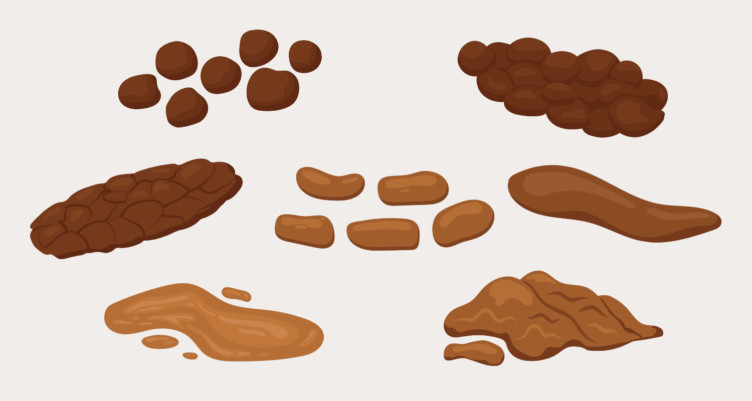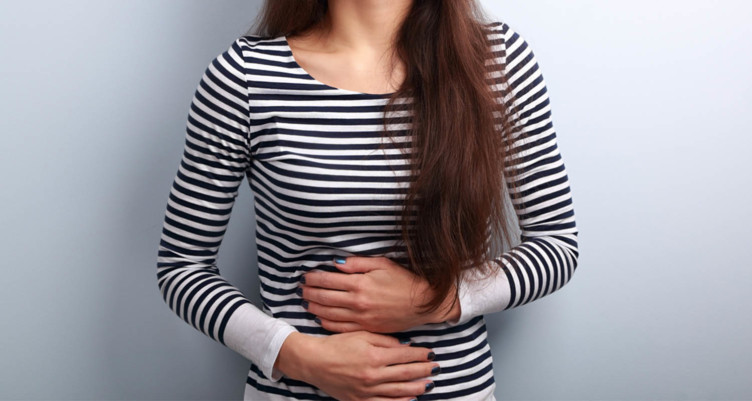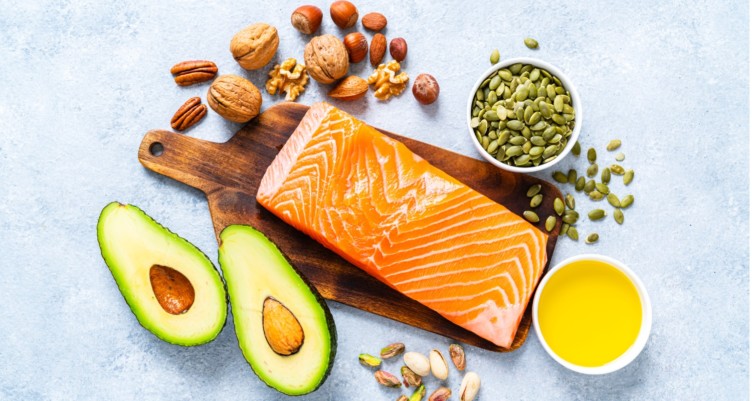This Poop Chart Identifies Different Types of Poop And What They Mean

- Paying attention to your poop can help you build a stronger gut, check your organ function and boost nutrient absorption from the foods you eat.
- The color, shape, texture and consistency of your poop tells you a lot about your digestive system and whether your diet needs adjusting. (Just glance in the toilet. This is not a hands-on exercise.)
- Check out the poop chart below to see where your bowel movements fall on the spectrum. Then, get tips to improve your digestion and gut health.
Right now, you may be ignoring one of your body’s informational super-sources: your poop. Your poop can tell you all sorts of things about your digestive health, including if you should adjust your diet, drink more water or see a gastroenterology specialist. Next time you’re in the bathroom, take a look in the toilet and then check the Bulletproof Poop Chart (below).
A small change could help you build a stronger gut, absorb more nutrients from your food and improve your good gut bacteria—positive changes that can lead to an even bigger impact on how you feel.
Read on to learn what different types of poop and bowel movements mean about your body. Then, learn how you can make adjustments to improve your health.
What does healthy poop look like?
What should poop look like, ideally? There are different characteristics to consider, including color, consistency and size. Here are a few ways you can assess whether you have healthy poop.
Color
Your poop should be brown in color, which comes from the combination of bilirubin (a pigment compound formed when red blood cells are broken down) and stomach bile.
Shape
Poop comes in many shapes. However, a log-like one is what you should be shooting for.
Size
Healthy poop is typically a few inches long. If it comes out in pellets, that could be a sign that your digestive system isn’t totally in sync.
Consistency
The firmness of your poop suggests a wealth of information about your body. So, is your poop soft, hard or runny?
You’ve probably already noticed the extremes, like runny or hard (which may be accompanied by constipation or hemorrhoids). Now, notice the subtleties: Is it lumpy or smooth? Are there ragged edges or clear-cut edges? Does it come out in soft blobs or more solid pieces?
Compare the consistency with each poop chart meaning for more insights into what your poop says about your health.
Length of time
How long should a poop take? It should be easy to pass, generally within a few minutes.
Frequency
The final thing to note about your poop is frequency: one or two poops a day, or only three times a week?
- Less than three times a week: Take magnesium to help your body send more water to your bowels.[1] Speaking of water, drink lots of it.
- Three or more times a day: You should probably eat more fiber from vegetables. Fiber slows down food passage through your digestive system, which gives you more time to absorb precious nutrients. If you’re getting lots of veggies and still pooping three or more times a day, see a doctor.
If you’re on a fairly regular schedule with your bowel habits, that’s a sign that your digestion is strong. Your poops should also generally feel “complete.” That means you feel like you’ve evacuated everything, and there isn’t more to come out.
Different types of poop and what they mean

Separate, hard lumps
How to fix it:
- Get plenty of water and take a magnesium supplement
- Take a teaspoon of Brain Octane Oil

Lumpy, dry, sausage-shaped
How to fix it:
- Get plenty of water and take a magnesium supplement
- Take a teaspoon of Brain Octane Oil

Solid, sausage-shaped with cracks on the surface

Smooth, like a soft sausage or snake

Soft blobs with defined edges
How to fix it:
- Eat more veggies
- Slowly add resistant starch, like green banana flour or raw potato starch

Mushy, ragged edges
How to fix it:
- Get plenty of water
- Increase healthy fiber intake
- Eat sweet potato, carrots and asparagus
- Experiment with fermented foods
- Take collagen daily

Liquid stool
How to fix it:
- Check with your healthcare provider if this happens regularly
If you’re curious about what your poop is trying to tell you, take a look at the Bulletproof Poop Chart. Based on the Bristol Stool Chart, this chart pairs examples with actionable tips.[2]
Here’s a rundown what different types of poop mean, along with their key identifying characteristics:
1. Marbles
Separate, hard lumps indicate constipation, likely due to dehydration.
2. Caterpillar
Dry, lumpy, sausage-shaped poop suggests mild constipation.
3. Hot dog
A sign of optimal poop health? Solid, sausage-shaped stool with cracks on the surface.
4. Snake
Smooth and snake-like poop is a strong indicator of a well-balanced diet and healthy digestion.
5. Amoebas
Soft blobs with defined edges signify a lack of fiber and potentially not enough good gut bacteria.
6. Soft service
Mushy, fluffy poop with ragged edges.
7. Jackson Pollock
Watery, no solid piece, completely liquid . If this persists, speak with your healthcare provider.
Poop color meaning

Keep an eye on your poop’s color.[3] It tells you how well your body is processing the food you eat and can provide clues about your digestive health.
Black
Black stools with a foul smell indicate a problem in the upper digestive tract, which may necessitate a visit to your healthcare practitioner. Your poop could also appear black if you consumed black licorice, blueberries, blood sausage, activated charcoal, Pepto-Bismol or iron pills.[4]
Green
Generally, poop ranging in shades of brown to green is a good sign. Consuming large amounts of green veggies could impact the color of your stool. However, green poop could also indicate that food moved through your gut too quickly.
Orange
Beta carotene, a compound that gives foods like sweet potatoes and carrots their orange color, could be the cause of orange stools.
Pale
Light gray, clay-like feces can suggest a problem with your digestion.[5][6] If your poop is regularly pale and gray, get yourself to a healthcare professional.
Red
Did you eat beets recently? If so, that may explain the change in color. Beets and some other red foods can cause your healthy stool to change colors because of their pigments. But if you haven’t eaten beets and you see red stool in the toilet, see a doctor about these irregularly colored bowel movements.[7]
Yellow
If your poop looks more yellow than brown, looks greasy and smells bad, it could be a sign that your body isn’t digesting fats well. It could also be a result of overconsumption of fatty and greasy foods.
Tips on keeping your poop healthy

How can you support healthy digestion and an optimal pooping experience? Here are some strategies to consider that can keep things moving in the right direction.
Eating foods that support healthy digestion
Feed your biome with prebiotic-rich foods like sweet potato, carrots and asparagus. Experiment with fermented foods like kombucha, sauerkraut and (if you tolerate dairy) grass-fed kefir. These fermented foods contain bacteria and yeasts that may be beneficial for your gut and gastrointestinal health—but keep in mind that fermented foods don’t work for everyone.
Drinking plenty of water
Staying hydrated keeps the stool in your large intestines soft, which makes it easier to pass. Not sure where to start? Check out our tips to stay hydrated.
Eating on a schedule
Following a consistent eating pattern could help your digestive system get accommodated to breaking down food at certain times of the day.
Exercise
Among its many benefits, exercise helps move food and gas through the digestive tract. So, if you want healthy poop, make movement a consistent practice.
Stay on top of colorectal cancer screenings
The American Cancer Society recommends that people at average risk of colorectal cancer start screening at age 45. You can do stool-based tests at home, but they have to be done more often than structural exams with scopes or x-rays.[8]
What does it mean if your poop floats?
Your stool’s buoyancy is especially useful info when you’re eating a lower-carb, high-fat diet like the keto diet because it’s a good test of whether you’re metabolizing and absorbing the fat you eat.[9]
Generally, poop should sink. If your poop is solid and occasionally floats, it could just be that you ate an especially large amount of fiber that day, which isn’t anything to write home about. But if your poop floats regularly, it could be a sign that you aren’t digesting fat. Watch for:
- Regularly soft, floating poop
- Oil slicks from the poop that coat the toilet bowl (like the grease left in the box when you pick up a piece of pizza. Yeah. That’s gross. Sorry.)
- Mucus in your poop or white stools
If your poop is oily once in a while, it could just be a side effect from eating too much fat. If it happens regularly, check your diet. Did you just switch over to a higher-fat diet? If so, your body can take a couple of weeks to start producing enough lipase, the enzyme you need to break down fat. To help in the meantime, taking lipase for a few days as a digestive supplement may help.
Poop smell
Poop naturally has an unpleasant smell. However, especially foul-smelling stools could indicate a problem with your digestive system. Malabsorption or an infection in the intestines from contaminated food typically result in stools that are runny and smell putrid.
Constipation
Occasional constipation could stem from a number of factors. Not consuming enough fiber may impact your pooping frequency. Or, you may not be staying adequately hydrated. Staying active and managing stress can help support a healthy gut and potentially provide some relief with occasional constipation.
Factors that affect bowel movements

Your daily habits can have a major impact on where you land on a bowel movement chart. Here are some factors that affect your digestive health:
- Food choices
- Fiber intake
- Hydration
- Stress
- Medication use
- Travel
When to talk to a doctor
If you haven’t changed anything and your poop floats in an oil slick on a regular basis, visit a doctor to get ahead of any serious conditions.[10][11]
If you’re grappling with chronic constipation, you should also speak to your healthcare provider. Constipation is one of those situations that can have many different causes.
The bottom line: Poop is a treasure trove of information about what’s going on inside your body. It may seem strange, but taking note of your poop gives you valuable insight into your digestion, organ function, gut bacteria and more. Keep tabs on your poop (or keep a poop journal, if you’re hardcore). It’s a great indicator of how small changes in your diet affect your gut—and healthy stool lets you know if you’re moving in the right direction.
If you’re feeling bloated, fatigued or just off, it may be time to check in on your gut health. Read on to learn about signs your gut is unhealthy and how to fix it.
Sign up for early access to sales, product launches, the latest Bulletproof news and more!
This article has been updated with new content.



